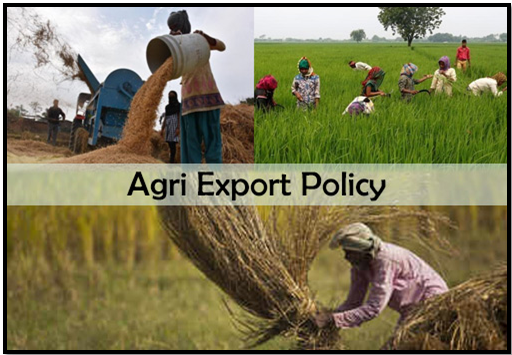MAKE EXPORT POLICY FARMER FRIENDLY
SYLLABUS:
GS 3: Major crops-cropping patterns in various parts of the country, – different types of irrigation and irrigation systems storage, transport and marketing of agricultural produce and issues and related constraints; e-technology in the aid of farmers.
Focus:
- Five months after implementing a restriction on onion exports due to anticipated shortages in the rabi harvest, India revoked the ban
Source: KNN India
Overview of Agricultural Export Trends
- Decline in Export Value: Agricultural exports dropped to $48.9 billion in 2023-24 from $53.2 billion in 2022-23.
- Failure to Meet Targets: The exports fell short of the $60 billion target set by the government.
- Slowed Growth Rate: The annual growth rate reduced significantly from 20% during 2004-05 to 2013-14 to just 1.9% from 2014-15 to 2023-24.
- Historical Comparison: Exports surged by nearly 500% from $8.7 billion in 2004-05 to $43.3 billion in 2013-14 but saw minimal growth thereafter.
- Trade Surplus Reduction: The trade surplus decreased from $27.7 billion in 2013-14 to $16 billion in 2023-24.
Key Agricultural Exports
- Rice: Tops the export list with $10.4 billion from 16.3 million tonnes, accounting for 21% of total agri-exports.
- Marine Products: Second highest at $7.3 billion, making up 15% of exports.
- Spices: Exported worth $4.25 billion, contributing 9% to the total.
- Bovine Meat: Amounts to $3.7 billion in exports, representing 8%.
- Sugar: Contributes $2.8 billion, which is 6% of the total agricultural exports.
Impact of Global Prices and Export Policies
- Sensitivity to Global Prices: Export volumes increase with high global prices but fall when prices decline.
- Export Restrictions: Bans and restrictions on commodities like wheat, rice, sugar, and onions have hindered export potential.
- Impact of Bans on Prices: Restrictions led to price increases internationally, as shown by the rice export ban in 2022.
- Optimal Export Quantity: Research suggests India should limit rice exports to 15-16 million tonnes to maximize revenue.
- Export Duty Recommendations: Suggests a 15% duty on common and parboiled rice to balance domestic supply and export revenue.
Environmental and Economic Concerns
- Water Usage in Rice Production: Each kilogram of rice requires 3,000-5,000 liters of water, raising sustainability concerns.
- Subsidy-Driven Competitiveness: Heavy subsidies on power and fertilizers give an artificial advantage that may be ecologically harmful.
- Exporting Virtual Water: Exporting rice also means exporting significant amounts of water, impacting local water resources.
- Need for Sustainable Practices: Emphasizes the need for investments in precision agriculture and resource-efficient techniques.
- Government Policies Impacting Farmers: Current export policies favor consumers and may harm farmers’ profitability.
Challenges in India’s Agricultural Export Policy
- Restrictive Export Policies: Policies often prioritize domestic consumers, impacting farmers negatively and hindering export growth. For instance, the Minimum Export Price (MEP) set at USD 1,200 significantly restricts basmati rice exports.
- Subsidy-Centric Schemes: Populist measures like loan waivers and subsidized utilities, while popular, can undermine fiscal discipline and the sector’s financial health.
- Inadequate R&D Investment: Investment in agricultural R&D is low at around 0.5% of agricultural GDP. This underinvestment limits growth and innovation in agricultural production and exports.
- Quality and Standards: Consistently meeting international quality standards poses a challenge. Issues like variability in quality and non-compliance with Sanitary and Phytosanitary (SPS) Measures restrict export opportunities.
- Infrastructure Deficiencies: Lack of adequate storage, transportation, and processing infrastructure leads to significant post-harvest losses, affecting export competitiveness.
- Global Competitiveness: Maintaining competitive pricing and quality is crucial as India faces stiff competition in the global market. Fluctuations in exchange rates further affect the competitiveness of Indian agricultural exports.
- Environmental and Sustainability Concerns: Increasing exports while ensuring environmental sustainability is challenging. Overexploitation of resources, such as water for irrigation, can lead to long-term ecological damage.
Steps Forward for a Stable Agricultural Export Policy in India
- Prioritize Farmer Welfare: Shift focus towards ensuring farmers are fairly compensated, linking their welfare directly to the success of agricultural exports.
- Domestic Consumer Support: Maintain food security through targeted income support policies for vulnerable populations, instead of broad subsidy schemes.
- Enhance Productivity: Boost competitiveness by doubling or tripling investment in agricultural R&D, modern seeds, efficient irrigation, and fertilizers.
- Diversify Export Portfolio: Expand the range of export commodities and focus on value-added products to reduce dependency on a few staples.
- Strengthen Quality Assurance: Implement rigorous quality standards and certification to meet international norms consistently.
- Infrastructure Improvement: Invest in modern infrastructure like cold storage and processing facilities to minimize losses and improve export quality.
- Adopt Advanced Technologies: Promote cutting-edge agricultural technologies and precision farming to increase productivity and sustainability.
- Implement Sustainable Practices: Encourage practices like organic farming to ensure environmental sustainability alongside agricultural growth.
- Adopt International Best Practices: Learn from global success stories in agricultural exports, negotiate favorable trade agreements, and reduce trade barriers to enhance market access.
Government Schemes to Promote Agricultural Exports in India
|
Source:Indian Express
Mains Practice Question:
Examine the impact of India’s export policy on agricultural growth and farmers’ income. Suggest measures to make the export policy more farmer-friendly. (250 words)




